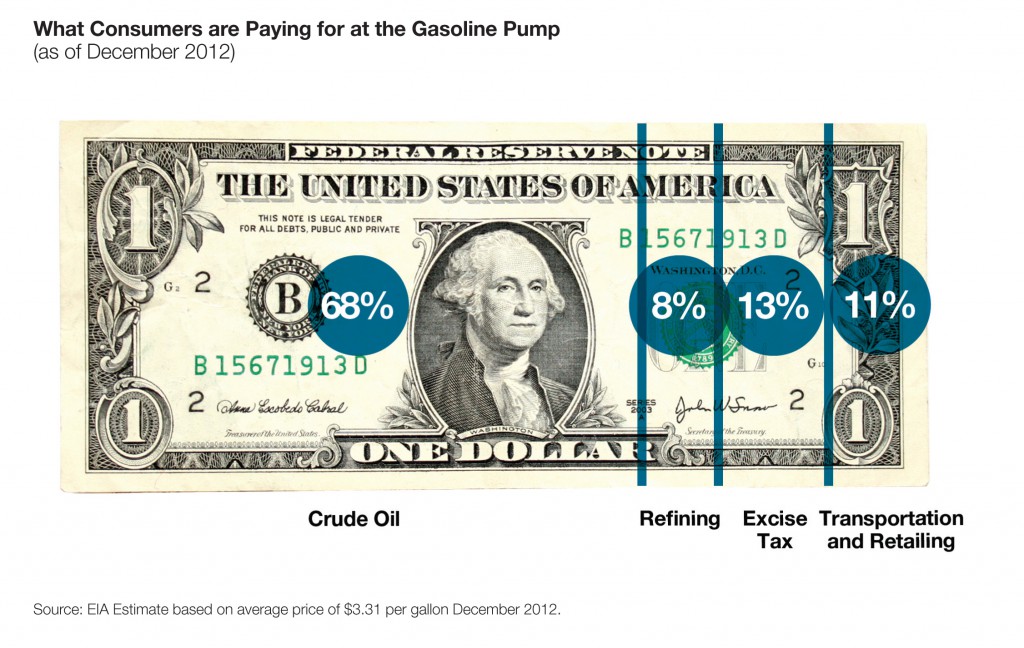My top 5 oil industry facts:
1) Oil is important. Shockingly, sometimes horrifically important.
The world economy has been developing with oil as its lifeblood for over a hundred years. Oil is directly responsible for about 2.5% of world GDP [1], but accounts for 1/3rd of humanity’s primary energy supply (>5 terawatts out of 15 terawatts total) [2]. It’s over half if you include natural gas.
World Energy Consumption by Source, in Terawatts
World energy consumption
Oil/gas powers 100% of all transportation, within a few significant figures of rounding error. Transportation, in turn, directly accounted for 1/6th of world GDP in 1997 [3] and is heavily involved in every other type of economic activity. Except for a minuscule number of electric-powered vehicles, you can’t move anything anywhere faster than about 25 mph without oil. You can’t operate a modern military, and you can’t run a modern economy. There is no doubt in my mind whatsoever that modern civilization would collapse in a matter of months if oil stopped flowing. Oil is about as important to the developed world as agriculture. It’s truly a condition for the continued existence of most of humanity today.
2) It’s big. Capital B-I-G BIG. You have no idea how big oil is.
The world’s oil & gas transport infrastructure is a globe-spanning spiderweb of pipelines and shipping routes. The natural gas distribution pipelines in the US alone could stretch from Earth to the Moon 7-8 times [4]. There are millions upon millions of miles of pipe on the planet to distribute crude oil, refined products, and natural gas. (Mostly gas.) Consider this: if your home has natural gas heat, it is connected via a continuous network of pipes to tens of thousands of wells drilled into subterranean rock strata that were laid down tens of millions of years ago. That’s pretty cool, really. Your house is directly connected to the Pliocene era — by the world’s oil & gas infrastructure.
About 40% of all seaborne cargo is oil [5], and there is literally more seaborne cargo at any given time (by weight) than there are fish in the sea [6]. Oil is in transit for a much shorter amount of time than the lifespan of most fish, so the total amount of oil that moves via water each year is much, much higher than the total amount of fish biomass. Think about what that means for a minute. The ocean isn’t full of fish, it’s full of oil cargoes.
Unfortunately, that scale makes it next-to-impossible to technologically disrupt the oil industry. This is going to make some people mad, but it’s reality. Not only is oil/gas critical now, but there are no viable replacements in our lifetime. People who think renewables can replace oil with a few decades of Manhattan Project style effort are simply ignorant of how big oil really is.
Even if we assume the energy-storage problem is solved soon, there is no reason whatsoever to think any feasible amount of renewables growth can displace fossil fuels in a couple generations. Wind and solar are growing exponentially, yes, but from such a small base that it doesn’t even make a dent — the use of renewables as a percentage of total world energy consumption only increased by 0.07% from 1973 to 2009 [7].
Let me break down some numbers.
- World oil production was 82 million barrels per day in 2010 [8]. At roughly 6 gigajoules per barrel, that’s about 5.7 terawatts of power production.
- World wind power production in 2010 was 0.3 petawatt-hours [9]. Averaged over a year, that’s about 34 gigawatts.
- World solar power production in 2010 was 0.03 petawatt-hours [9]. Averaged over a year, that’s about 3.4 gigawatts.
So world energy production from oil alone is 2 orders of magnitude higher than wind power, and 3 orders of magnitude higher than solar power. Let me pick on solar power a little, because it’s downright embarrassing to compare the two:
- The difference in power generation between solar power and oil production is more than the difference between a professional bicyclist and a Formula 1 racecar.
- If solar power generation doubled every decade for 100 years, it would still be pretty far behind oil today.
These numbers get significantly worse if you add in natural gas and coal. And much worse still if you allow for expected demand growth.
Sorry guys, but regular old exponential growth isn’t even enough. Tomatch oil, you’ll need half a century or more of clear energy superiority. That means cleaner and cheaper and more concentrated for storage. Nothing fits the bill yet. To replace oil, you’ll need a century to allow the entire economy to retool and realign around the new technology.
[Update: I am greatly simplifying the solar issue to illustrate the point that oil is big, which lots of people have objected to in the comments. Based on historical energy system uptake rates and continuing price declines, 50-200 years is a realistic time range for solar to hit 5TW generation. I think it’ll take 100 years, and many people think it’ll be a lot faster. That’s fine; this isn’t an answer about solar power, because you can’t use solar power as a transport fuel in any practical way. Mass adoption of electric cars is still pretty far down the road. Pun intended.]
3) Oil is wealth. Not just wealth for producers, but wealth for everyone who uses it.
The historical use of cheaper, more-concentrated, and cleaner energy sources seems to be one of the most direct causes of economic growth. Even more importantly, it causes vast improvement in the human condition. Simply put, better sources of energy increase productivity and produce fewer negative externalities. This effect is huge. Cheap, abundant energy lifts nations out of poverty. China understands this. Failure to secure energy supplies dooms nations to collapse. The Mayans found this out too late.
Energy efficiency is powerful and highly desirable, but it can’t compete with increasing the primary energy supply. Most of the time, increased energy efficiency actually results in increased energy consumption, because of cheaper costs (per unit output) and faster economic growth. This is called Jevon’s Paradox (Jevons paradox). Highly-developed nations can use advanced technology to increase quality of life while using less energy, but less-developed nations cannot. Getting to developed-nation status required a lot of high-quality energy.
And oil is indeed high-quality energy. It’s liquid, which makes it easily moved and stored. It’s stable, and it releases a huge amount of energy. It’s also much, much cleaner than coal. If it weren’t for CO2 emissions, oil & gas would be a nearly-perfect energy source. Look at what their growth has done to the world’s wealth:
World per Capita Real GDP vs World per Capita Energy Consumption by Type
World Energy Consumption Since 1820 in Charts
File:World GDP per capita 20th century.GIF
Those two charts don’t match by accident. Every transition to a cleaner, cheaper, more-concentrated energy source causes dramatic improvements in real global wealth (and quality of life). Electrification caused most of the growth from 1900 to 1950. Oil enabled the post-war boom from 1950 to 1970, and natural gas strongly contributed to the growth from 1970 to 1995. The growth since 2000 has, unfortunately, been largely been due to increased coal consumption in Asia. The digital revolution and Great Recession have played a large part in global wealth trends, but mostly in the parts of the world that were already wealthy by global standards.
Ok, so maybe you don’t care about GDP, and want to know about quality of life. Energy is fundamentally required for a high quality of life, as measured by the UN’s Human Development Index. There is a range of energy consumption that depends on climate and population density, but broadly speaking, high-consumption countries have the highest quality of life.
Energy Consumption in Kilogram-Oil Equivalent per Year vs Quality of Life
HDI, Energy Consumption and CO2 Emissions
Sure, the biggest energy consuming nations could reduce per capita consumption a lot, and still have high quality of life. The US could learn a lot from Denmark. And current trends show that they are steadily moving in that direction — energy consumption per capita and per dollar of GDP is steadily dropping in the developed world. That’s a good thing.
But the energy required to lift 3 billion people out of poverty is far, far more than the potential energy savings from eliminating energy waste in the developed world. I’m not talking about stretch-SUVs and 60″ TVs, I’m talking about refrigeration for vaccines, irrigation for agriculture, and fuel for school buses. The planet cannot support 7 billion people at a low-energy agrarian level of existence — we have long since passed the point where we can revert back to a low-tech, low-energy form of civilization without billions of people dying of starvation.
All those green and red dots in the chart need to move past the blue dotted line — it is truly a moral imperative to allow the world’s poor to enjoy the basic fruits of development. That will require an enormous amount of new energy production capacity. Thankfully, the world mostly needs electricity, which is much easier to expand than oil. But we need a lot of oil too.
Oil is energy, and energy is wealth.
4) The oil industry is a really safe place to work.
Despite the Hollywood stereotypes, oil rigs are actually quite safe. Don’t get me wrong, there are lots of extremely hazardous activities at a drill site, but they’re exceptionally well-managed. Working on an oil rig used to be pretty dangerous — lots of older guys in my office are missing parts of their fingers. But the industry has made huge strides in safety improvements over the past few decades by increasing automation, providing comprehensive safety training, and changing the work culture. It’s a different world now.
Accident rates have been dropped steadily since the 1990s, to the point the oil industry is now safer than many regular occupations. The OSHA statistics prove it. “To really put safety in perspective, the average 2.1 TRIR for rig operations is lower than [OSHA’s] 3.3 TRIR for real estate. You are safer statistically on the rig floor than driving around with a real estate agent.” [10]
Land rigs have about the same injury rate as a regular construction job, and offshore rigs have a lower injury rate than being a teacher. In the chart below, the oil industry is rolled up into “mining”:
http://www.bls.gov/iif/oshwc/osh…
Jobs that are actually dangerous include truck-driving, logging, fishing, and nursing. I’ll happily deal with swinging cranes, high-pressure chemicals, toxic oil fumes, and offshore helicopter flights — but you couldn’t pay me enough to be a nurse. They have it rough.
5) Oil companies don’t really make that much money.
Contrary to popular belief, the Oil “Majors” — ExxonMobil, Chevron, BP, Total, ConocoPhillips, and Shell — don’t actually make all that much money. Yes, it’s a lot in absolute terms because the companies are so large, but the profit margins are pretty sad in agood year. Bad years (like most of the 1990s) cause crippling contractions and mass layoffs.
Recent Profit Margins at Exxon, Apple, Microsoft
WolframAlpha: profit margins of exxonmobil, apple, microsoft
[Update: Lots of people have objected in the comments to using two large, well-established tech companies as comparison points for ExxonMobil. I think they’re very good comparisons. All three are extremely large, world-class engineering organizations, operating in high-risk, high-tech, capital-intense markets with long supply chains. They are all affected by the business cycle more than the norm, and have long development times for new ventures. Their production facilities cost immense sums and steadily become obsolete. They have a lot of competition from overseas companies who copy their ideas, and they have to repeatedly take large financial gambles on new technology and markets to stay in business. Oil is more like the tech sector than it’s like other extractive industries. On the other hand, “national” oil companies (OPEC etc) are a very different story, and I’m not talking about them here.]
Oil Companies Underperformed the S&P500 through the 1990s
Google Finance
Go ahead, accuse me of cherrypicking data. You have a point, but the same can be said about the recent high profits that everyone complains about. Yes, profits have beat the S&P500 lately, because oil prices are very high right now. Guess what? Exploration & development costs are rising faster than the price of oil. Net revenue per barrel at the Majors (not profit, just revenue) is only running about $20/bbl even though oil has gone up from ~$40/bbl to ~$100/bbl. What happens when China’s big recession hits, and oil demand drops significantly? The price will plummet by 2-3x, just like it did at the start of the Great Recession. This is an incredibly capital-intensive industry, in which large projects take longer to execute than the length of the business cycle. That’s fundamentally difficult to manage.
Oil is a widely-traded, high-competitive commodity market. That means basic economics causes profits margins to go as low as they can without companies exiting the industry. In this case, 8-10% profit margin is the minimum risk premium you can offer a company to convince it to continue doing business in:
- A market where your product is almost completely interchangeable with the next guy’s product
- A cyclic industry that sees 4-5x swings in the price of finished goods, with steadily-rising input costs
- A business where each $100 million exploration well has a 50-90% chance of being a failure
- A business where a bad mistake means $40 billion in fines & damages
- A market dominated by government-run companies who are held to lower environmental and legal standards
- Countries with a history of illegally nationalizing oil infrastructure
- A fairly hostile regulatory environment
- A fairly hostile PR environment
Frankly, it’s a miracle anyone wants to be in this business at all. I truly think the major oil companies are underpaid. The risk-adjusted returns are crap compared to most sectors. The only way oil companies survive this kind of business environment is by consolidating, so that the risks are spread out over a wider base. That’s why oil companies are some of the largest publicly-traded companies in the world — because they have to be huge to survive.
So where does all the oil money actually go? To national oil companies — mostly OPEC. They have control of all the cheap oil that’s easy to get out of the ground, so they have a combination of high net revenue per barrel and some semblance of cartel pricing power. Don’t make the mistake of thinking the Majors and the Nationals are in the same league — Saudi Aramco is estimated to be worth about four times as much as the top ten publicly-traded corporations put together, which includes ExxonMobil, PetroChina, Shell, and Chevron [11]. Oil is such a behemoth of an industry that the big players dwarf the world’s largest corporations.
There’s lots to know about the oil industry — people spend their entire careers learning small slices of it — but if more people understood the facts above, we would have much more productive public discourse about the world’s energy systems.
[1] A Primer on Energy and the Economy: Energy’s Large Share of the Economy Requires Caution in Determining Policies That Affect It
[2] World energy consumption
[3] http://www.nssga.org/government/…
[4] Natural Gas Pipelines, Distance from Earth to Moon
[5] http://www.whoi.edu/science/MPC/…
[6] Ships
[7] The Rising Renewables ” CSBE
[8] World, U.S. Oil Production Rises in 2010
[9] Scientific American, April 2013, “The True Cost of Fossil Fuels”How to Measure the True Cost of Fossil Fuels
[10] SPECIAL REPORT: Oil, gas safety statistics mark progress.
[11] Saudi Aramco,
List of corporations by market capitalization


















